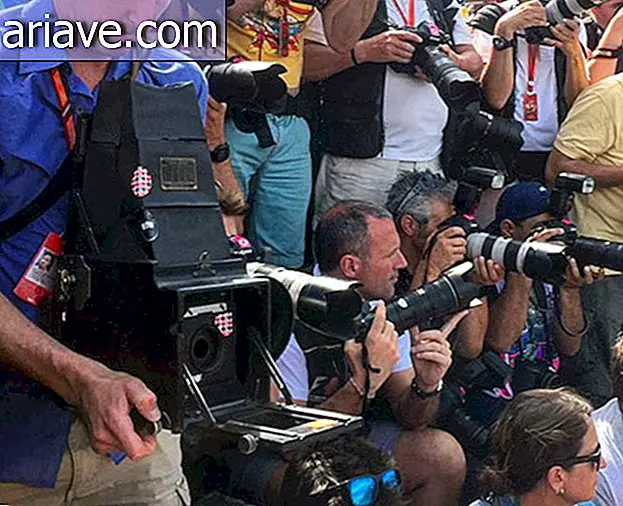7 very bizarre ways to 'read' luck
Many people seek some answers to situations of their lives in some practice of clairvoyance or guesswork, by attending fortune tellers, tarot players or other methods. The world is (and has been in the past) full of types, from the simplest to the most absurd, of ways to read luck. Check out some of the most bizarre.
7 - The clairvoyant's clairvoyance

Alectromancy was the practice of predicting the future through the divination power of the fowl! First, a chicken (or a rooster, preferably) was placed in the middle of several piles of grain. Each pile represented a letter and the answer to each question asked to the animal was revealed according to the pile that was pecked by it.
The ritual was prepared with the rooster, which should be white, with its claws cut and wrapped in sheepskin. Afterwards, the animal was left without food for a long time, to be hungry during the ceremony and to peck the piles. After that, the “organizers” chanted a “magical prayer”, placing the animal in the middle of the grain.
And one more detail: this all had to be done when the moon or the sun were in the constellation of Aries; otherwise it would not work. The "science" of rooster divination was taken as predicted by the successor of Roman Emperor Valens (Flavius Julius Valensus 328-378 AD), though the details are vague and often contradictory.
Some say that Valiant himself ordered the guesswork so that he could find and eliminate all possible opponents who would attempt to take his throne.
6 - Haruspacia

Haruspacia meant predicting and even influencing the future through detailed study of the bowels of animals, usually the liver. Although it was the most famous used by the Romans, it was actually an Etruscan practice.
Believing that their god Tages passed them on to his followers, the Etruscans continued to use the method even after their civilization was assimilated into the Roman Empire. And the Romans saw haruspacia and its practitioners as very powerful, so much so that even the Roman philosopher Cicero wrote about them.
The most famous haruspacia "wizard" was named after Spurinna. He was highly respected in his day and was called by none other than Julius Caesar to make predictions. His most famous prediction was later immortalized by Shakespeare in his play about the doomed emperor.
The soothsayer warned Caesar, "Beware of the gone of March, " which corresponded to March 15, the day he was murdered. Although this may seem strange, it has been suggested that Spurinna was already aware of the plot behind Caesar's murder.
5 - Parakeet Astrology

Originally from South India, “parrot astrology” gained more popularity in Singapore with this nomenclature. But despite their name, the birds used to guess the future are actually parakeets, usually green. Although each fortune teller has his or her own unique style, a session usually begins with the client saying his or her name, while the fortune teller has a series of cards based on indigenous cosmology.
That done, the session conductor opens the cage, the parakeet leaves, and selects a card to determine the client's luck. After choosing, the bird returns to its cage. Surprisingly, a “seer” parakeet named Mani successfully predicted the 2010 FIFA World Cup quarterfinal qualifiers.
However, the animal could not predict the winner of that year's World Cup. Despite Mani's fame, parakeet astrology is a decadent art, as Singaporeans are losing faith in the ability of animals.
4 - Eschatomancy (or “Cocology”)

The eschatomancy, or divination through the feces, already dates from centuries of existence and various ways to be performed. The best known was developed in ancient Egypt, where the movement of beetles (a species of beetle) was analyzed while they were shrouded in dung.
Another ancient mode reported was that ducks were placed in an enclosed area where they ate and defecated while a reader of eschatomancy "read" the waste. Others read the meaning of their own feces, trying to guess something by analyzing the shape, texture and even the smell of excrement. Nice, isn't it?
3 - “Asparagomancy”

An England-based “asparagomancer” named Jemima Pacoti claims to be able to predict the future using asparagus. She says she has been reading asparagus since she was 8 years old, having inherited her grandmother's "gift", who also practiced reading tea leaves.
Your guessing method is tossing the vegetables in the air and analyzing how they land. To her credit, she predicted England's strong performance at the 2012 Olympics, an event that was later announced as the nation's best performer than any other Olympics of all time.
2 - Rumpology (or “Bundology”)

Rumpology is the practice of guessing a person's future from the shape of their butt! Jackie Stallone, the foremost rumpologist in the United States, claims that this is an old practice that was already used in various civilizations of the past, although it provides no evidence for this statement.
According to Stallone, the ancients knew how to “read” their buttocks after painting them with henna before sitting on a papyrus, so she reads prints and photos of the “rear” her clients send her.
According to science, which we may also call "bundology, " it is possible to reveal aspects of a person's personality by looking at the details of the shape and circularity of the butt. But the system goes further.
Stallone says he accurately predicted election results by reading his dog's backside. Although quite dubious, rumpology has spread to many countries, including Germany, where a blind rumpologist feels the butt of clients for his readings. Not to be called a profiteer, he says his blindness guarantees his clients anonymity and says that his disability is a blessing.
1 - The nipple of fortune

There is also such divination through the "mystical power" of the human halo, more specifically in Japan. The practice became popular there after a "magician" named Eri Koizumi appeared on Japanese TV wearing a nipple-shaped beret to publicize her book on the subject.
According to Japanese practice, divinations are mainly told by the shape of the halo, revealing personality traits. Color would also be another determining factor for reading.
However, this practice is as crazy as it sounds. According to List Verse, Koizumi is known as a magician, but registered with a talent agency as a comedian. So the whole thing is probably a big joke, although some people from Japan took it seriously.
* Posted on 8/28/2014











